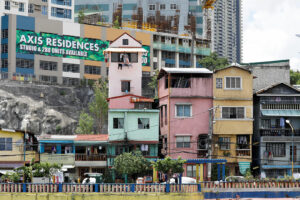RESIDENTIAL PROPERTY PRICES nationwide rose at a slower pace in the first quarter, the Bangko Sentral ng Pilipinas (BSP) said.
Data from the central bank showed that the Residential Real Estate Price Index (RREPI) rose by an annual 6.1% in the January-March period but slowed from the 6.5% growth in the previous quarter and 10.2% expansion a year ago.
This was also the weakest growth in nationwide home prices since the 2.6% recorded in the second quarter of 2022.
On a quarterly basis, residential property prices grew by 1.1%, a turnaround from the 3.6% decline in the fourth quarter.
The RREPI tracks the average price changes of residential properties across different housing types and locations. This provides the central bank with insights into the property market, which is regulated due to bank exposure.
Joey Roi H. Bondoc, associate director for research at Colliers International Philippines, attributed the slowing price growth to weak demand for residential projects.
“We are seeing flattish growth in prices due mainly to tepid demand in the residential market. In Metro Manila, only 3,000 units were sold in the pre-selling sector, down 52% year on year. We are also seeing this in terms of launches, which dropped 59% year on year,” he said in an e-mail.
Data from the BSP showed that prices of condominium units rose by 10.2% year on year. This was faster than 4.1% a quarter earlier and 1.2% in the same period a year ago.
Duplex housing unit prices jumped by 36.2% in the first three months, a turnaround from the 33.5% contraction a quarter ago and faster than the 22.1% growth a year prior.
Prices of townhouses grew by 5.6%, faster than 4.9% in the fourth quarter and 1.8% in the same period in 2023.
Meanwhile, prices of single-detached/attached houses rose by 5.1%. This was much slower than 9.5% in the previous quarter and 17% a year ago.
Mr. Bondoc noted that horizontal projects remain attractive, especially among overseas Filipino workers (OFWs) but demand has yet to return to pre-pandemic levels.
Housing prices in the National Capital Region (NCR) went up by 2.8% in the first quarter, slower than 4.3% a quarter ago and 7.3% a year earlier.
“On a year-on-year basis, residential property prices in the NCR rose by 2.8% in the first quarter of 2024 as the growth in the prices of townhouses and condominium units outweighed the decline in the prices of single-detached/attached houses,” the BSP said.
On the other hand, housing prices in areas outside NCR (AONCR) jumped by 7.4%, slower than 7.8% in the fourth quarter and 11.4% in the year prior.
“We are projecting demand growth to come from areas outside NCR, including central Luzon, Calabarzon, Western Visayas, Central Visayas, and Davao Region especially for house-and-lot and lot only developments,” Mr. Bondoc said.
Meanwhile, residential and real estate loans granted for all types of new housing units rose by 8.9% in the first quarter, much slower than the 30.5% growth in the fourth quarter and 16% a year ago.
Broken down, housing loans in NCR and AONCR increased by 3.2% and 11.4%, respectively.
Majority of the loans were used to purchase single-detached/attached houses (43%), condominium units (34.7%), and townhouses (22%).
In the first quarter, the average appraised value of new housing units in the Philippines stood at P82,260 per square meter (sq.m.).
The average appraised value in NCR stood at P132,743 per sq.m., while the average appraised value in AONCR was at P61,163 per sq.m.
“Moving forward, we expect developers to be more cautious in launching pre-selling condominium units in Metro Manila given that the remaining inventory life (RIL), or the length of time needed by the market to absorb pre-selling and ready for occupancy (RFO) units, is still at about three years,” Mr. Bondoc said.
He also noted the impact of elevated interest and mortgage rates.
“While horizontal (house-and-lot and lot only) projects are among their preferred properties, still elevated mortgage rates compel OFW buyers to wait-and-see,” Mr. Bondoc said.
The Monetary Board has kept its benchmark rate unchanged at 6.5%, the highest in over 17 years, for a sixth straight meeting last week.
“If there is no interest rate cut for the remainder of the year, we might still see tepid demand in the residential sector. Given this, we do not see a substantial spike in demand and prices for the remainder of 2024,” he added.
BSP Governor Eli M. Remolona, Jr. has said it is still on track to easing rates as soon as August, by possibly 25 basis points (bps).
The central bank could reduce rates by 25 bps again in the fourth quarter, he added. — Luisa Maria Jacinta C. Jocson
